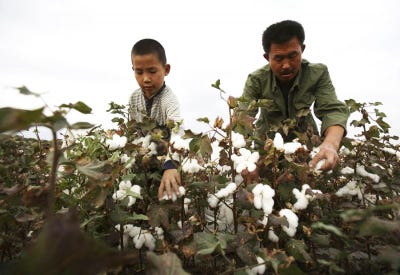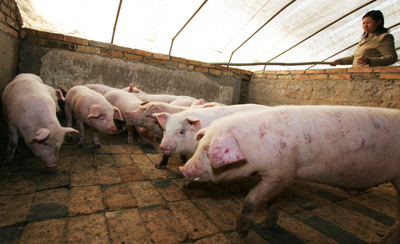
China is growing less cotton — millions of bales less — and that spells opportunity for the U.S., despite China having 50 million to 60 million bales of its own cotton sitting in reserves.
“Three years ago, China produced 35 million bales; two years ago, 32 million bales; last year, about 31 million bales,” says O. A. Cleveland, Jr., Extension economics professor emeritus at Mississippi State University and a veteran cotton analyst.
“ As we move into 2015, unless something happens we’re going to see their production drop another 5 million bales, and by 2016-17 another five million bales — down to 20 million bales,” he said at the joint annual meeting of the Mississippi Boll Weevil Management Corporation and the Mississippi Farm Bureau Federation Cotton Policy Committee.

CHINA continues to plant less cotton as it concentrates more on feed/food grains. — Photo copyright China Images, Getty Images
“Within just a five-year period, they will have gone from 35 million bales of production all the way down to 20 million bales,” he says.
China’s textile industry “will remain very strong — perhaps not the size it is now, but still exceptionally strong. Much of the investment they’ve been putting into bricks-and-mortar and machinery is starting to go to Vietnam, Cambodia, Laos, and Myanmar.
Vietnam is booming, busting at the seams,” Cleveland says. “I was there several months ago, and it’s just exploding.”
GET THE LAGEST AG NEWS delivered daily to your inbox: Subscribe to Delta Farm Press Daily
The Chinese government, he says, is insisting that the country is moving to a free market economy for both cotton and soybeans, and that they’re willing to let prices fall as the market dictates.
More food production
“They’re moving much more toward a food-producing agriculture rather than a fiber-producing agriculture. They will continue to support cotton prices in Xinjiang Province, the big upper northwest desert area that they’re clearing, where they have huge water reservoirs.

RAPID INCREASES in hog production has resulted in China growing less cotton and more feed grains. — Photo copyright China Images, Getty Images
“But the east coast of China will see more feed grains — corn and oilseeds — and some rice. Their hog industry is six times larger than ours, and it’s going to be 10 times larger. It’s incredible! They made the switch to pork to give their people more meat instead of chicken, and they’re growing more feed grains for all those hogs.
“Everything the Chinese government has told us to date about their cropping and food intentions, and their move to a free market for cotton and beans, they have done — and this means the cotton price in China is going to fall.
“Chinese textile mills that have been paying as much as $1.75 per pound for cotton are now paying only $1.35,” Cleveland notes. “Where they were reimbursing growers with a target price of $1.40, now it’s going to drop to $1.20-$1.15 in the Xinjiang Province.
“They’ve identified that area as where they’re going to produce their cotton. It can be grown more efficiently there than in the eastern seaboard areas. If they do what they say they’re going to do, they won’t support the price of cotton in the eastern seaboard areas, and that will drive cotton out of that area.
“So, the handwriting is pretty much on wall that China will be producing less cotton.”
Stocks are lower quality
In the short term, Cleveland says, China has 50 million to 60 million bales of cotton stocks that are overhanging the world market.

CHINESE textile mills are focusing more on production of quality yarns, pointing to more purchases of higher quality U.S. cotton. — Photo copyright China Images, Getty Images
But, he says, “Those stocks are at least two years old, and most of the cotton is three or four years old, so other than using it to make cheap yarns, they have no choice except to import higher quality cotton to mix with their cotton in order to spin quality yarns.
“China has increasingly moved toward producing quality yarns, and their textile mills are wanting quality cotton. That’s why we’ve been selling so much U.S. cotton.”
Cleveland says the USDA’s World Agricultural Outlook Board has “grossly underestimated Chinese cotton demand the last five years — that’s documented — and in my opinion, they’ve grossly underestimated it again. Three years ago, China imported 20 million bales, two years ago they imported 14 million bales, last year they imported 12 million bales. But the WAOB has China importing only 8.5 million bales of 2014 crop cotton, which I believe is too low.”
Chinese mills don’t want the cotton its government has in storage, he says. “Yes, they’re buying some of it, but they will have to continue buying U.S. cotton to maintain quality. Our exports to China are still very active.
“I would guess as the U.S. crop gets bigger, at least three of every four bales we grow will go to the export market, and rather than USDA’s export projection of 8.5 million bales, we’ll probably hit 12.5 million to 13 million bales, simply because we’re going to have a larger crop and a lower price.”
India has been on track to become the world’s largest cotton producer, Cleveland says, “but it looks like China may stay above them this year. There’s no doubt, though, that India will become the world’s largest producer — if not this year, perhaps next year.”
Concerns about India’s current crop, centered on fears their monsoon was going to be very late, is “another reason the market had gone higher, he says. “Instead, it came early, and everyone was excited that India was going to plant a lot of acres.
“Then, the monsoon disappeared. Sixty percent of the cotton acres in India aren’t getting the rains needed to make the crop. They’ve quit planting and are just sitting there watching the skies. Only about 40 percent of the crop is getting decent rains.
“India still has time to produce 28 million to 32 million 480 lb. bales,” Cleveland says. “The USDA projects them at 38.5 million. The market is kinda teetering right now with respect to India’s production outlook, but whatever cotton we may be losing in India we’re making up here in the U.S.
“But the New York cotton futures contract is U.S. based, so right now we’re paying more attention to the U.S. crop.”
About the Author(s)
You May Also Like




